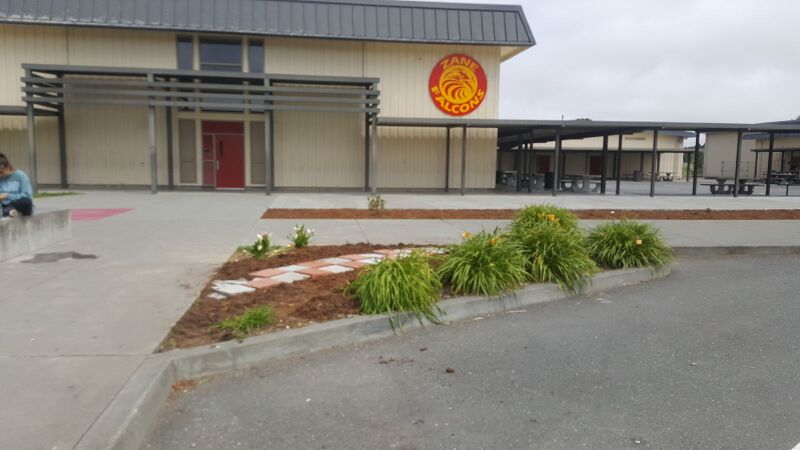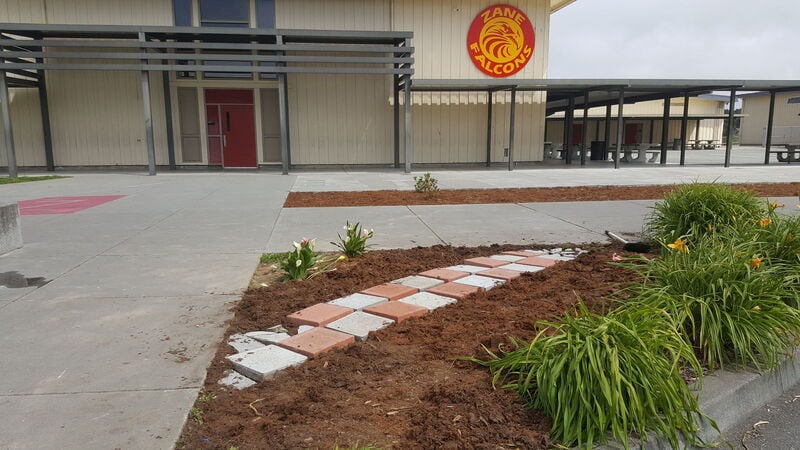Sabrinna RR (talk | contribs) |
Sabrinna RR (talk | contribs) |
||
| Line 141: | Line 141: | ||
|File:PLACEHOLDER.jpg |falconhead design for stepping stone|1 |Create a design. | |File:PLACEHOLDER.jpg |falconhead design for stepping stone|1 |Create a design. | ||
|File:FalconHeadStamp.JPG| |2 |Make a stamp from it. | |File:FalconHeadStamp.JPG| |2 |Make a stamp from it. | ||
|File: | |File:FalconHeadStone.JPG| |3 |Make a mould that will be the size of the stepping stone wanted | ||
}} | }} | ||
Revision as of 23:50, 1 May 2017

Abstract
The goal of this project is to design and create designated concrete stepping stone pathways to replace a preexisting rectangle shaped area filled with mulch in front of the school for the students at Zane Middle School in Eureka, California. Pathways will incorporate school spirit and education value by having falconhead imprints on each concrete square that makes up the path. There should be an image near the top. (image will be added when final design is complete)
Background
This project is carried out by the group, The Green Dream Team under the supervision of instructor Lonny Grafman in the 2017 Spring semester of the Engineering 215 Introduction to Design course at Humboldt State University in Arcata, California. The administrator of this project is Trevor Hammons, whom is the Counseling Services Director at Zane Middle School. An organized aesthetically pleasing walkway system through the rectangular area is what Trevor wishes to be fulfilled. The falcon heads will be created in an MC escher style, which is the interlocking of one image within itself in an ongoing pattern. A pathway that contains easy accessibility and school inspired design produces a safe and positive learning environment while the students are walking to class.
Problem statement and criteria
The objective of this project is to provide a piece of land that will be used to improve the aesthetic value of the school. In order to do so, native plants, pathways, and benches will be placed. Not only would this help beautify the school but also act as a pick up area for the children. This area is expected to last for a long period of time so there should be an ease of navigation and be maintainable.
| Criteria | Weight (#) |
|---|---|
| Ease of Navigation | 10 |
| Aesthetics | 9 |
| Safety | 8 |
| Durability | 8 |
| Ease of Maintenance | 7 |
| Level of Sustainability | 3 |
| Inspiration | 2 |
| Education | 2 |
Description of final project
The tessellating concrete paths at Zane Middle school are placed in solely the rectangular site location. The triangular portion of the groundwork features a pathway of alternating red and white tiles to form a checkered pattern. Spaces have been left around the tiles for the placement of grass seed in order to secure the tiles. Smaller pieces of pavers are located at the edge of either end of the path. Three Cala lilies are contained within the triangular segment.

Costs
| Quantity | Material | Source | Cost ($) | Total ($) |
|---|---|---|---|---|
| 1 | Bender Board | The Mill Yard | 20.00 | 20.00 |
| 1 | Quikrete | The Mill yard | 5.00 | 5.00 |
| 1 | Quikrete Portland Cement | The Mill yard | 12.95 | 12.95 |
| 1 | Quikrete All Purpose Sand | The Mill yard | 7.95 | 7.95 |
| 1 | Cala Lily | Costco | 6.95 | 6.95 |
| 2 | Plastic Bucket | The Mill yard | 5.95 | 5.95 |
| 1 | Wooden Spoon | ACE | 2.95 | 2.95 |
| 10 | Red Concrete Pavers | Mill Farms | 1.99 | 19.9 |
| Total Cost | 88.60 | |||
Testing Results
Tests will be - (i) stepping stones: (a) adhesion to mud, (b) do they pass the kid lift test?, © general aesthetics (ii) layout: (a) general aesthetics, (b) Z’s or N’s?
How to build
Maintenance
The groundworks project requires very little maintenance due to the permanent stability of the concrete stepping stones.
Instructions
Troubleshooting
-Stepping stone cracks: Replace stepping stone
-Residue and rocks get into design: sweep out remains in order to provide traction
Discussion and next steps
Temporary: Following the final implementation of the design will be the analyzing of how it has affected the school. Seeing how the design on the stepping stones is included is learning activities and the success of those lessons will determine how well they impacted the school. Lastly, the way that the students use the pathways to diminish traffic will be seen to reflect on how it works.
Suggestions for future changes
This section will be filled in once knowing how the final product is used by the students and how it could be better with changes (This is where to lay out suggestions for how to make the project function better in the future. )
References
Schnelle, Michael A. “Greenhouse Floors and Benches.” Oklahoma Cooperative Extension Service, <pods.dasnr.okstate.edu/docushare/dsweb/Get/Document-1287/HLA-6703web.pdf> (Feb. 19, 2017).
“Why Concrete?” MIT Concrete Sustainability Hub, https://cshub.mit.edu/why-concrete> (Feb. 18, 2017).
“The Use of Solid Waste Materials as Fine Aggregate Substitutes in Cementitious Concrete Composites,” Center for Transportation Research and Education, <www.ctre.iastate.edu/PUBS/semisesq/session2/shehata/index.htm> (Feb. 19, 2017).
Danks, Sharon Gamson (2010). Asphalt to Ecosystems: Design Ideas for Schoolyard Transformation. New Village Press. Oakland, California.
“Integrated Materials and Construction Practices for Concrete Pavement: A State-of-the-Practice Manual.” (2007). U.S. Department of Transportation – Federal Highway Administration, <https://localroads.wisc.edu/sites/default/files/imcp_manual_october2007.pdf> (Feb. 19, 2017).
Ostrovsky, Nick. “Greenhouse Benches.” <depts.washington.edu/propplnt/Chapters/Greenhouse_benches.htm> (Feb. 19, 2017).
“Laurel Tree Charter School three scoops three benches,” Appropedia, last modified October 28, 2014. <www.appropedia.org/LaurelTree_Charter_School_three_scoops_three_flavors_benches> (Feb. 20, 2017).
"Aggregates." Aggregates. N.p., n.d. Web. 23 Feb. 2017.
"Chapter 4 Permeability." Developments in Petroleum Science Integrated Flow Modeling (2000): 41-56. Web.
Designing Circulation Areas. Gütersloh: Birkhäuser Verlag GmbH, 2013. Web.
Guidance on the Permeable Surfacing of Front Gardens. Wetherby: Dept. for Communities and Local Government, 2008. Web.
"Guide for Maintaining Pedestrian Facilities for Enhanced Safety Research Report - Safety | Federal Highway Administration." Guide for Maintaining Pedestrian Facilities for Enhanced Safety Research Report - Safety | Federal Highway Administration. N.p., n.d. Web. 23 Feb. 2017.
In 2006 And 2007, The Division Of Water Qual-, Ity, North Carolina Department Of Environment, Implemented And Natural Resources (Ncdenr), and Design Guidance And A Design Requirement That. Permeable Pavement: Research Update and Design Implications (n.d.): n. pag. Web.
"Permeable Pavement Parking Lot." Office of Campus Sustainability. N.p., n.d. Web. 23 Feb. 2017.
Quality, Department Of Ecology Water. Article: Permeable Pavements - Reduce Runoff Thru Pervious Layers (n.d.): n. pag. Web.
"Table 3.3 Angel Capital Statistics from CVR." (n.d.): n. pag. Web.
"Zane Middle School Native Memorial Garden." Zane Middle School Native Memorial Garden - Appropedia: The Sustainability Wiki. N.p., n.d. Web. 23 Feb. 2017.
Permeable Pavements. Reston: American Society of Civil Engineers, 2015.
Kim, Yail, Adel Gaddafi, and Isamu Yoshitake. "Permeable Concrete Mixed with Various Admixtures." Materials & Design, 100 (2016): 110-119.
Arms, Karen. “Environmental Gardening”. Halfmoon Publishing. 1992. Print.
Brady, Nyle. “The Nature and Properties of Soils”. Macmillian Publishing Company, New York. 1990. Print.
Charles E. Carraher Jr., John P.Droske Journal of Chemical Education2006 83 (10), 1428 Concrete : Design, Construction, Examples. Basel : Munich: BirkhaÌuser ; Edition Detail, 2006.
Haiken, Melanie. “Basic Lawn Care Tips”. Hgtv.com. 2017. Web.
Hansen, Beth. “Mulch and Soil Fertility”. Rodalesorganiclife.com. 26 August 2013. Web. 20 February 2017.
Iannotti, Marie. “Mulch - What Is It and Which Mulch Should You Use Where?”. Thespruce.com. 19 January 2017. Web. 20 February 2017.
Kaiser, Laura. “Low Maintenance Lawn Alternatives: Ground Cover”. Houselogic.com. 2017. Web.
“Lawn Alternatives”. Eartheasy.com. 2014. Web. http://eartheasy.com/grow_lawn_alternatives.htm
Pratt, Chris. “Environmental Gardening”. eagantigua.org. The Environmental Awareness Group of Antigua and Barbuda. 28 November 2010. Web. 20 February 2017.
“Soil pH”. Cropnutrition.com. 2016. Web. http://www.cropnutrition.com/efu-soil-ph
“What’s the ideal fertilizer ratio for turfgrass?”. Turf.unl.edu. University of Nebraska. 2012. http://turf.unl.edu/turfinfo/Ideal%20Fertilizer%20Ratio.pdf